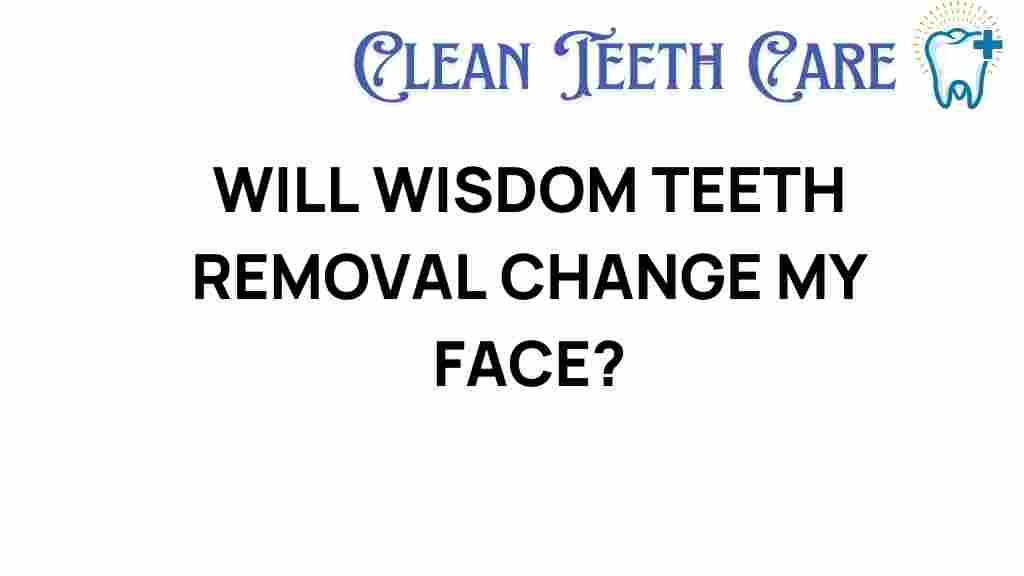Unveiling the Truth: Will Wisdom Teeth Removal Change My Face?
Wisdom teeth, also known as third molars, are often the source of confusion and concern for many individuals. As these teeth emerge in late adolescence or early adulthood, questions arise about their impact on dental health and aesthetics. One of the most common inquiries is whether wisdom teeth removal can change facial structure. In this article, we will explore the relationship between wisdom teeth, oral surgery, and how they might affect jaw alignment and overall facial aesthetics.
Understanding Wisdom Teeth
Wisdom teeth typically emerge between the ages of 17 and 25. For some, they come in without any issues, while for others, they can cause a range of problems, including:
- Pain and discomfort
- Crowding of existing teeth
- Infection or gum disease
- Cysts or tumors
Due to these potential complications, many dental professionals recommend the removal of wisdom teeth. However, patients often wonder about the effects of this oral surgery on their facial structure.
The Impact of Wisdom Teeth on Facial Structure
To understand whether wisdom teeth removal can change your face, it’s essential to consider several factors related to jaw alignment and dental health.
1. Jaw Alignment
The presence of wisdom teeth can lead to misalignment of the jaw. If these teeth are impacted or grow at odd angles, they can push against neighboring teeth, causing:
- Shifting of teeth
- Changes in bite alignment
- Jaw discomfort or pain
Removing wisdom teeth can alleviate these issues, potentially leading to a more balanced jaw alignment, which may have a subtle effect on facial aesthetics.
2. Facial Aesthetics
Facial structure is influenced by the dental arch, which includes all teeth in the mouth. If wisdom teeth are causing crowding or shifting, this can result in:
- Unevenness in the smile
- Changes in facial proportions
- Alterations in cheekbone visibility
Post-removal, as the dental arch stabilizes, individuals may notice slight improvements in their facial aesthetics. However, significant changes are unlikely unless additional orthodontic treatments are pursued.
Myths Surrounding Wisdom Teeth Removal
There are several myths about wisdom teeth removal and its effects. Let’s debunk a few of the most common misconceptions:
Myth 1: Wisdom Teeth Removal Will Dramatically Change Your Face
While the removal of wisdom teeth can improve jaw alignment and reduce discomfort, it is unlikely to result in dramatic changes to your face. Most alterations are subtle and may not be noticeable to others.
Myth 2: Everyone Needs Their Wisdom Teeth Removed
This is not true. Some people have enough space in their mouths to accommodate their wisdom teeth without any issues. Regular dental check-ups can help determine if removal is necessary.
Myth 3: Recovery is Always Prolonged
Recovery varies from person to person. Many individuals experience a quick recovery with minimal discomfort, especially when following post-operative care instructions.
The Wisdom Teeth Removal Process
If you’ve decided to proceed with wisdom teeth removal, understanding the process can help ease any concerns you may have.
Step 1: Consultation
Your journey begins with a consultation with your dentist or oral surgeon. They will evaluate your dental health, discuss any symptoms, and take X-rays to assess the position of your wisdom teeth.
Step 2: Anesthesia Options
During the procedure, anesthesia options will be discussed. You can choose from:
- Local anesthesia (numbing the area)
- Sedation anesthesia (you’ll be relaxed but awake)
- General anesthesia (you’ll be asleep during the procedure)
Step 3: The Procedure
The oral surgery typically lasts about 45 minutes to an hour. The surgeon will remove the wisdom teeth and may use stitches to close the extraction sites.
Step 4: Recovery
Post-operative care is crucial for a smooth recovery. Expect some swelling and discomfort, which can usually be managed with prescribed pain relief. Follow these general recovery tips:
- Rest and avoid strenuous activities for a few days.
- Apply ice packs to reduce swelling.
- Stick to soft foods for the first few days.
- Maintain oral hygiene, but avoid rinsing vigorously.
Troubleshooting Recovery Issues
While most recoveries are smooth, some individuals may encounter issues. Here are troubleshooting tips for common problems:
Issue 1: Prolonged Pain or Swelling
If pain or swelling persists beyond a few days, contact your dentist. This could indicate an infection or dry socket.
Issue 2: Difficulty Eating
Stick to a diet of soft foods, such as yogurt and mashed potatoes. Gradually reintroduce solid foods as you heal.
Issue 3: Oral Hygiene Concerns
Gently brush your teeth, avoiding the extraction sites, and rinse with salt water after 24 hours to keep the area clean.
Conclusion
In summary, while the removal of wisdom teeth can have an impact on jaw alignment and may lead to subtle changes in facial structure, it is not a guaranteed method for achieving dramatic aesthetic improvements. Understanding the role of wisdom teeth in your dental health is crucial. If you have concerns about your wisdom teeth or their potential effects on your facial aesthetics, consult with your dentist or oral surgeon.
For more information on dental health and wisdom teeth, visit Dental Health Resources.
Remember, your smile is an essential aspect of your overall appearance, and addressing wisdom teeth issues can be a positive step towards better oral health and enhanced aesthetics.
This article is in the category Treatments and created by CleanTeethCare Team
